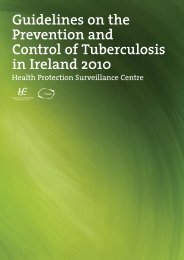Guidelines for the Early Clinical and Public Health Management of ...
Guidelines for the Early Clinical and Public Health Management of ...
Guidelines for the Early Clinical and Public Health Management of ...
Create successful ePaper yourself
Turn your PDF publications into a flip-book with our unique Google optimized e-Paper software.
<strong>Guidelines</strong> <strong>for</strong> <strong>the</strong> <strong>Early</strong> <strong>Clinical</strong> <strong>and</strong> <strong>Public</strong> <strong>Health</strong> <strong>Management</strong> <strong>of</strong> Bacterial Meningitis (including Meningococcal Disease)<br />
Chapter 4: Surveillance<br />
Key points<br />
Surveillance is required to:<br />
• Ensure prompt identification <strong>and</strong> appropriate management <strong>of</strong> cases <strong>and</strong> close contacts in order to<br />
implement appropriate control <strong>and</strong> communication measures to monitor changes in epidemiology<br />
<strong>and</strong> effectiveness <strong>of</strong> control measures to provide evidence <strong>for</strong> local <strong>and</strong> national guidelines<br />
Case definitions used in surveillance are available (see section 4.3 below <strong>and</strong> on HPSC website)<br />
Clinicians <strong>and</strong> laboratories are legally required to:<br />
• Notify all cases <strong>of</strong> suspected bacterial meningitis, invasive meningococcal or Hib disease to public<br />
health immediately without waiting <strong>for</strong> microbiological confirmation<br />
• Notify all cases <strong>of</strong> pneumococcal meningitis upon microbiological confirmation<br />
Departments <strong>of</strong> public health should:<br />
• Undertake enhanced surveillance on all cases<br />
• Implement prompt public health interventions as appropriate<br />
• Monitor disease incidence <strong>and</strong> trends<br />
• Evaluate public health interventions <strong>and</strong> policies<br />
• Review regularly surveillance data at local level (<strong>Health</strong> Protection Surveillance Centre reviews<br />
data at both national <strong>and</strong> regional level).<br />
4.1 Surveillance <strong>of</strong> bacterial meningitis (including meningococcal, Hib, pneumococcal, streptococcal group B<br />
disease)<br />
Surveillance is based on notification <strong>of</strong> cases by clinicians <strong>and</strong> laboratories. Notification is a statutory requirement <strong>of</strong><br />
both clinicians <strong>and</strong> laboratories.<br />
4.2 Objectives <strong>of</strong> surveillance<br />
The objectives <strong>of</strong> disease surveillance are:<br />
• To ensure prompt identification <strong>and</strong> appropriate management <strong>of</strong> cases<br />
• To ensure prompt identification <strong>of</strong> close contacts in order to implement appropriate control <strong>and</strong> communication<br />
measures<br />
• <strong>Public</strong> health control measures are required <strong>for</strong> meningococcal disease <strong>and</strong> H. influenzae type b disease (<strong>and</strong><br />
rarely invasive pneumococcal disease) to prevent ongoing transmission<br />
• To monitor changes in <strong>the</strong> epidemiology <strong>of</strong> <strong>the</strong> disease in relation to serogroup, serotype <strong>and</strong> antibiotic<br />
susceptibility<br />
• To monitor effectiveness <strong>of</strong> current control measures (vaccination programmes, chemoprophylaxis to contacts)<br />
• To provide an evidence base <strong>for</strong> local <strong>and</strong> national guidelines.<br />
All clinicians <strong>and</strong> laboratories should immediately notify cases <strong>of</strong> suspected meningococcal or H. influenzae infection<br />
by telephone, fax, or email. Laboratories using CIDR should also report all cases through CIDR. Notification <strong>of</strong><br />
suspect meningococcal or Hib cases should not be delayed until microbiological confirmation is obtained.<br />
4.3 Surveillance case definitions 33<br />
Case definitions have been defined <strong>for</strong> all notifiable disease in Irel<strong>and</strong> since 2003 <strong>and</strong> updated cases definitions<br />
were produced in January 2012. A case definition means <strong>the</strong> set <strong>of</strong> clinical or microbiological characteristics by which<br />
a case <strong>of</strong> infectious disease is defined. This in<strong>for</strong>mation is used to classify <strong>the</strong> notifications as possible, probable<br />
or confirmed. The classification according to <strong>the</strong> different levels might vary according to <strong>the</strong> epidemiology <strong>of</strong> <strong>the</strong><br />
individual diseases.<br />
Prior to this case definitions <strong>for</strong> meningococcal disease had already been defined <strong>and</strong> were used <strong>for</strong> surveillance.<br />
The following case definitions are used to define <strong>the</strong> most commonly reported notifiable diseases associated with<br />
meningitis.<br />
-36-

















